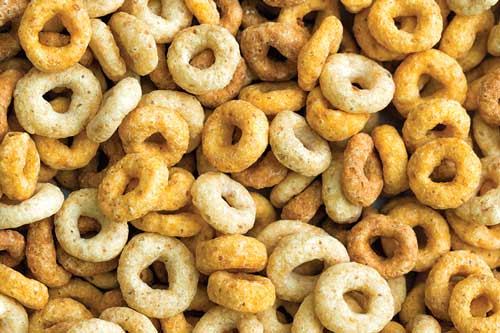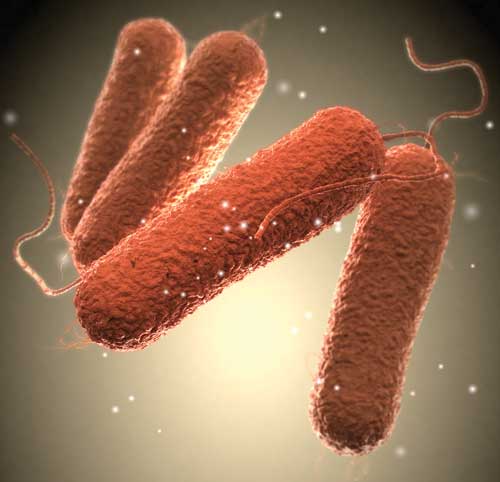Validating the Safety of Low-Moisture Foods
FOOD SAFETY AND QUALITY
 Low-moisture foods are food products with water activity (aW) equal to or less than 0.85. Breakfast cereals, grains, confections such as chocolate and cocoa, dairy and egg powders, dried fruits and vegetables, honey, seeds, nuts, peanut butter, chips and other snacks, spices, and herbs are among the many examples. Low-moisture foods are less susceptible to microbial spoilage and growth of foodborne pathogens than higher-moisture products. Although pathogens, such as Salmonella, can’t grow in these products because of the low aW, they can remain viable for long periods of time and can cause illness due to their low infectious dose and through post-processing temperature abuse or contamination.
Low-moisture foods are food products with water activity (aW) equal to or less than 0.85. Breakfast cereals, grains, confections such as chocolate and cocoa, dairy and egg powders, dried fruits and vegetables, honey, seeds, nuts, peanut butter, chips and other snacks, spices, and herbs are among the many examples. Low-moisture foods are less susceptible to microbial spoilage and growth of foodborne pathogens than higher-moisture products. Although pathogens, such as Salmonella, can’t grow in these products because of the low aW, they can remain viable for long periods of time and can cause illness due to their low infectious dose and through post-processing temperature abuse or contamination.
Targeting Salmonella
Salmonella has been linked over the years to numerous foodborne illness outbreaks related to low-moisture foods and ingredients. As recently as June 2018, the U.S. Food and Drug Administration (FDA) and the Centers for Disease Control and Prevention investigated a 31-state outbreak of Salmonella Mbandaka infections linked to sweetened puffed-wheat cereal. Organizations have developed guidelines for processing low-moisture foods to eliminate Salmonella and other pathogens. The Almond Board of California instituted a pasteurization program in 2007 to treat almonds, requiring a validated minimum four-log treatment and establishing standard protocols and guidelines for blanching, oil roasting, dry roasting, and steam and moist-heat processes.
In March 2009 the FDA issued a draft guidance for industry, addressing the risk of contamination by Salmonella species in foods containing peanuts and in June 2009 issued another draft guidance regarding foods containing pistachios (the agency finalized the pistachio guidance in September 2011). The FDA said that Salmonella becomes more heat-resistant as the aW of a food decreases. For example, it takes less than five minutes to achieve a five-log reduction of Salmonella at 140°F in a food with an aW of 0.99 but 50 minutes in a food with an aW of 0.85. The agency added that the composition of the food, such as fat content, protein content, and acidity, may also affect heat resistance. For example, it can take more than six hours to obtain a five-log reduction of Salmonella in milk chocolate at 194°F and more than 30 hours at 160°F. Salmonella is expected to be more heat-resistant in foods like peanut butter (aW of 0.35) than in a food with an aW of 0.85.
In the 2014 report “Ranking of Low Moisture Foods in Support of Microbiological Risk Management,” the Food and Agriculture Organization (FAO) and the World Health Organization (WHO) ranked Salmonella species as providing the highest percentage of illness outbreaks. The Codex Alimentarius Committee on Food Hygiene referenced the FAO/WHO report when it issued “Code of Hygienic Practice for Low-Moisture Foods” in 2015. The code, revised in 2016, focused on control of Salmonella.
In November 2015 the FDA issued final regulations implementing the preventive controls rules for human and animal foods, which are part of the regulations implementing the Food Safety Modernization Act. The rules require that processors implement and validate interventions to prevent or control identified hazards, such as Salmonella in low-moisture products. The agency issued a guidance for small entities in November 2016 and a draft guidance for industry in January 2018.
 Alliance Focuses on Pasteurization
Alliance Focuses on Pasteurization
Bradley Marks, professor of biosystems engineering and food science at Michigan State University, said that processes that have been used for years to manufacture low-moisture foods (such as baking, roasting, and toasting) were generally designed for quality, but processors are now required to validate that the process has a pathogen-control, or kill, step. They need to design a validation study, using either an in-plant test with a nonpathogenic surrogate organism that behaves like the pathogen or pilot-plant or laboratory studies that mimic the process.
To help in this regard, the Low-Moisture Food Pasteurization Alliance began a five-year project in 2015 called “Enhancing Low-Moisture Food Safety by Improving Development and Implementation of Pasteurization Technologies.” Funded by the National Institute of Food and Agriculture of the U.S. Dept. of Agriculture (USDA), the project is being conducted by researchers from Michigan State University, Washington State University, University of Nebraska, University of Georgia, North Carolina State University, Institute of Food Safety and Health (IFSH) at the Illinois Institute of Technology, and the FDA. Equipment, ingredient, and service suppliers and food companies are also involved in advisory capacities.
Marks, who is director of the alliance, said that the overall goal of the project is to enhance the development, validation, improvement, and commercial adoption of pasteurization technologies that ensure the microbial safety of low-moisture foods. Specific objectives are to develop standardized protocols for evaluation and validation of low-moisture food pasteurization technologies; conduct inoculated challenge studies with representative products treated by multiple process technologies such as steam, radio frequency, extrusion, drying, and gas; develop and evaluate improvements to thermal processes such as drying, baking, and roasting; and develop multiple outreach, training, and service resources.
 A study using the nonpathogenic microorganism Enterococcus faecium, six standardized test materials (almonds, peanut butter, wheat flour, nonfat dry milk, ground black pepper, and dates), and a standardized cocktail of five strains of Salmonella (Agona, Enteritidis, Tennessee, Montevideo, and Mbandaka) showed that E. faecium appears to be a robust surrogate for Salmonella. However, product characteristics significantly affected that relationship, indicating that it is necessary to consider product composition when validating thermal processes for low-moisture foods.
A study using the nonpathogenic microorganism Enterococcus faecium, six standardized test materials (almonds, peanut butter, wheat flour, nonfat dry milk, ground black pepper, and dates), and a standardized cocktail of five strains of Salmonella (Agona, Enteritidis, Tennessee, Montevideo, and Mbandaka) showed that E. faecium appears to be a robust surrogate for Salmonella. However, product characteristics significantly affected that relationship, indicating that it is necessary to consider product composition when validating thermal processes for low-moisture foods.
An extrusion study using an oat-flour oil-based product showed that lethality decreased as fat content increased and moisture content decreased. The results also demonstrated greater reduction of Salmonella than E. faecium across all treatments, providing further support of using E. faecium as a surrogate for Salmonella.
Studies on baking of biscuits and crackers and roasting of pistachios demonstrated that humidity significantly enhances lethality. The baking study also indicated decreased pathogen lethality with increased fat content and that the cold spot is not necessarily the least-lethal spot in a thermally processed product since drying of the product surface can impede pathogen inactivation. This is significant, Marks said, because a traditional approach focused on the cold spot might overestimate actual pathogen lethality. A study on walnut roasting showed that the uncertainty of process lethality decreased with increasing humidity, and a study on almond roasting demonstrated that air velocity significantly impacts process lethality independently of the changes in product surface temperature.
The alliance has presented workshops and presentations at meetings of the Institute of Food Technologists, International Association for Food Protection, American Society of Agricultural and Biological Engineers, IFSH, and others. Most recently, members of the alliance participated in the short course “Controlling Pathogens in Low-Moisture Foods” at IFT18. Alliance members have also published their results in peer-reviewed scientific journals.
Addressing Water Activity
Water activity is a measure of how much of the water in a product is free (unbound) and thus available for chemical and physical reactions and microbial growth. While temperature, pH, oxygen availability, and several other factors also influence whether and at what rate microorganisms will grow in a product, aW is often the most important factor. It is calculated as the ratio of the water vapor pressure of a substance to that of pure water under the same conditions and is equal to the equilibrium relative humidity expressed as percent divided by 100. It is measured by placing a sample into a closed chamber, equilibrating the liquid-phase water in the sample with the vapor-phase water in the headspace, and measuring the relative humidity of the headspace.
Brady Carter, southwestern regional sales manager at Perten Instruments and advisor to the alliance, said that as aW increases, all degradative reactions (chemical, physical, and microbiologica) increase. Measuring aW is part of the research and development of products, and once the aW range that provides maximum stability and shelf life is known, it becomes a specification for production. There’s no real way to measure aW online, he said, since measurement of aW requires equilibrium, but the instrument can be put right at the production line to provide feedback so that adjustments in the process can be made if the product is not meeting the specification.
Marks said that although aW is a key factor in shelf life determination, it hasn’t been looked at in terms of processing. The processor needs to measure aW to document that the process is achieving the desired kill. The alliance is investigating how Salmonella resistance relates to changes in aW during processing. A special aW meter, not commercially available, was custom designed by METER Group for use in studying the effect of high temperature on aW and used by multiple laboratories in the alliance project.
Carter said that the meter consists of a metal container containing a relative humidity sensor that can tolerate high temperatures. The sample is placed into the container, which is then sealed and placed into an oven, so readings can be taken at temperatures up to 100°C—something that couldn’t be done before because the electronics couldn’t withstand the high temperatures, he said. The electronics are located outside the container, not in the oven, so the meter can track changes in equilibrium relative humidity as temperature increases.
Water Activity Meters
• Capacitance hygrometers (manufactured by METER, Novasina, and Rotronics) consist of two charged plates separated by a hygroscopic polymer membrane. As the membrane adsorbs water, its ability to hold a charge increases. The resulting capacitance change is approximately proportional to the water activity (aW) as determined by a sensor calibrated against known saturated salt standards.
• Resistive electrolytic hygrometers (manufactured by Novasina) are essentially the same as capacitance hygrometers but use a resistive electrolyte sensor instead of a polymer.
• Chilled-mirror dew point hygrometers (manufactured by METER) pass air over a chilled surface with a temperature that is gradually reduced. The temperature at which the water vapor begins to condense on the surface (the dew point), detected by an optical reflectance sensor, is directly related to the vapor pressure of the air. A sample is placed into a sample cup that is sealed inside a chamber containing a sensor that measures the dew point temperature of the air. An infrared thermometer measures the sample temperature. The relative humidity of the headspace is calculated as the ratio of dew point temperature saturation vapor pressure to saturation vapor pressure at the sample temperature. When the aW of the sample and the relative humidity of the air are in equilibrium, measurement of the headspace humidity gives the aW of the sample.
• Tunable diode laser instrument (manufactured by METER) is the newest approach. Whereas other types of instruments are sensitive to volatiles such as propylene glycol or ethanol that might be present, the tunable diode laser measures all kinds of products with no limitations for volatiles. It’s similar to the chilled-mirror instrument but uses a laser in place of a mirror. As the chilled mirror measures the dew point temperature to determine vapor pressure, the tunable diode laser measures the vapor pressure by tracking the attenuation of a laser beam shone through the headspace. Since the laser is only affected by the presence of water, the attenuation of the laser signal is directly proportional to the vapor pressure in the headspace.
 Neil H. Mermelstein, IFT Fellow,
Neil H. Mermelstein, IFT Fellow,
Editor Emeritus of Food Technology
[email protected]


